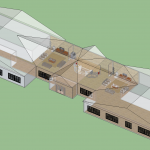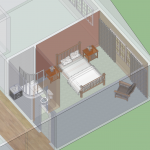This week Russ began modeling the Mountain Resort. We decided that for an appropriate size for the resort (based on the size of our mountain) to make the structure approximately 200′ long x 50′ deep. Based on time limitations, we will keep it very simple to limit the time spent modeling the structure to focus on adding detailing elements to the mountain itself. The general structure of the resort is in place, but I will continue this week to model more rooms and work on applying surface finishes in more of the rooms. Because we want the participants to experience the ski hill more than the mountain resort, more of our focus is on the mountain itself at this time.
Nick worked this week on fine tuning the geometry of the mountain, including creating a flat surface on top where the users will start skiing, and the mountain resort will be placed. He also worked on making the 3 ski runs more individualized so that they vary in difficulty level. We are working on creating the jumps on the various runs, and working on trying to incorporate a half pipe (hopefully we can get it to work with our model!).
Dan worked on the code for our model this week since we were having some trouble getting it to launch on the LEL screen. We were finally able to get the person to move, though are fine tuning the settings and code to make it as realistic as possible.
Dan was able to figure out how to move and rotate the skiis and “attach” the user to the skiis. He is still working on figuring out the following:
-right now you can either rotate or move, you can’t do both (basically, we move by applying a force, and we rotate by applying a Euler translation, and for whatever reason the Euler translation seems to cancel out any applied force)
-when you attach the user to the skiis, they disappear
-there is still some bizarre bounding box stuff going on. I’m not sure if it is due to the way the mountain is represented (probably) or the skiis (also possible), but a lot of times the skiis will bounce of invisible things due to (I’m assuming) bounding box errors
(we are trying to address this as we fine tune the mountain model)




















